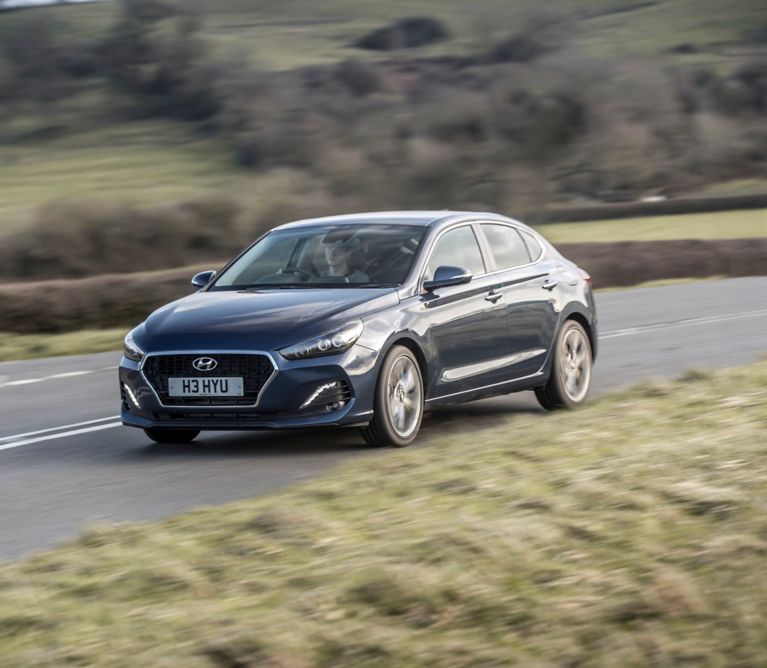Press material
-
Download
-
Images
The i30 Fastback is powered by two small-displacement turbocharged petrol engines delivering a dynamic and efficient driving experience.
Both engines come with Hyundai’s Idle Stop and Go (ISG) system as standard for increased efficiency.
Customers can choose between the 1.4 T-GDi four-cylinder engine with 140 PS (torque: 242 Nm @ 1500 rpm; CO2 emissions combined: 142 - 124 g/km*) or the 1.0 T-GDi three-cylinder engine with 120 PS (torque: 171.1 Nm @ 1500 ∼ 4000 rpm; CO2 emissions combined: 135 - 125 g/km*). Mated to the engines is either the six-speed manual transmission (6MT) or – as an option on the 1.4 T-GDi – Hyundai’s efficient and direct-responding seven-speed dual-clutch transmission (7DCT).
Customers can choose between the 1.4 T-GDi four-cylinder engine with 140 PS (torque: 242 Nm @ 1500 rpm; CO2 emissions combined: 142 - 124 g/km*) or the 1.0 T-GDi three-cylinder engine with 120 PS (torque: 171.1 Nm @ 1500 ∼ 4000 rpm; CO2 emissions combined: 135 - 125 g/km*). Mated to the engines is either the six-speed manual transmission (6MT) or – as an option on the 1.4 T-GDi – Hyundai’s efficient and direct-responding seven-speed dual-clutch transmission (7DCT).
1.0 T-GDi – three-cylinder dynamism
The 1.0 T-GDi engine, developed by the Namyang Technical Centre in Korea in collaboration with the European Technical Centre in Germany, with 120 PS and 171 Nm provides a perfect combination of dynamism and efficiency with combined fuel consumption of up to 51.4 mpg* and CO2 starting from as low as 125 g/km*.
A turbocharger with an electronically-controlled waste-gate actuator improves fuel efficiency by lowering pumping losses as well as improving throttle response and low-end torque. The unit features a six-hole GDi injector, pressured to a higher-than-average 200 bar, securing a clean combustion and improving fuel economy and emissions.
To keep the engine unit as small as possible, the exhaust manifold is integrated in the cylinder head and can therefore be cooled efficiently using the cylinder head water-cooling system. These efforts result in faster warm-up of the catalyst and ultimately in improved real-world fuel consumption and emissions.
The 1.0 T-GDi is offered with the 6MT.
1.4 T-GDi – frugal and fun to drive
The 1,353 cc four-cylinder turbocharged petrol engine is significantly lighter than its predecessor, the Gamma 1.4-litre engine. The unit’s base weight has been reduced by 14 kg and it also boasts greater efficiency and power, delivering 140 PS and 242 Nm of torque with combined fuel consumption of up to 51.4 mpg* and CO2 from as low as 124 g/km*.
The engine incorporates a high-pressure single-scroll turbocharger integrated in the exhaust manifold to improve operational efficiency. The relocated and re-engineered turbo means throttle response time and low-end torque have improved. The design injects fuel directly inside the cylinder, improving combustion rates for better power and fuel efficiency.
The turbocharged 1.4-litre T-GDi petrol engine is offered with the 6MT or the 7DCT, which gives a choice of fully automatic operation or manual gear changes.
Low emissions performance
The i30 range is now equipped with Euro 6d-TEMP engines to meet the latest EU regulations. To ensure the i30 range complies with the new emission standards, the T-GDi engine benefits from a Gasoline Particulate Filter (GPF) which is designed to control particulate emissions.
The seven-speed Dual-Clutch Transmission
Hyundai Motor introduced its first seven-speed double-clutch transmission in 2015, combining the benefits of automated and manual transmissions. The 7DCT provides an improvement in fuel consumption and CO2 emissions of up to 20% compared to a conventional six-gear automated transmission, while acceleration performance could be increased by up to 10%.
The 7DCT consists of two dry clutches and an actuator for each clutch. Engine power is transferred independently into the odd and even gear train to always be ready to shift into the next gear without any torque interruption. For optimised responsiveness the electric motor-driven actuator is applied, while external dampers reduce the noise, vibration and harshness during driving.
In combination with the 7-speed dual clutch transmission, the i30 offers two drive modes: normal and sport. In sport mode there is a different shift pattern that holds gears for longer before changing, while the steering provides a sporty feel and the throttle response is adapted.
Ride and handling
The i30 range has been developed and tested in Europe, performing accelerated durability tests and dynamic testing in the most demanding surroundings in the world – including the famous Nürburgring Nordschleife – to ensure that the high expectations of European customers are met.
The development engineers have defined unique characteristics for the i30 Fastback; compared to the i30 Five-door, the stiffness of the suspension has been increased by 15% and the chassis has been lowered by 5 mm. The reduced roll angle decreases understeer, which is results in more agile and fun-to-drive overall ride and handling.
The new body type of the i30 Fastback provides a dynamic and compliant driving experience with high levels of ride comfort. Contributing to this is the standard multi-link rear suspension for all versions, with a dual lower arm and performance-oriented shock absorbers.
Strong and lightweight body
Hyundai Motor is the only car manufacturer to make its own steel for the production of its vehicles globally, with great benefits for the i30 Fastback, which features a strong and light body that enhances the dynamic performance and increases passenger safety.
* Based on NEDC Test Cycle. Fuel Consumption and emission values vary depending on tyre size and transmission type.









